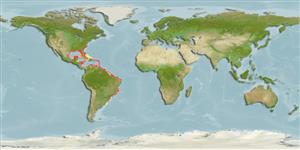Malacostraca |
Decapoda |
Portunidae
Environment: milieu / climate zone / depth range / distribution range
Ecology
Benthopelagic; brackish; depth range 0 - 75 m (Ref. 367). Tropical, preferred 26°C (Ref. 107945); 35°N - 38°S, 98°W - 34°W
Western Atlantic: USA to Argentina.
Length at first maturity / Size / Weight / Age
Maturity: Lm 59.5 range ? - ? cm Max length : 13.9 cm CW male/unsexed; (Ref. 367); 11.3 cm CW (female); max. reported age: 2.50 years (Ref. 85497)
Carapace slightly more than twice as broad as long; 9 teeth on arched anterolateral margin 9outer orbital tooth and strong lateral spine included) progressively more acuminate laterally; outer pair of frontal teeth (excluding inner orbital angles) prominent but inner pair small. Much of convex dorsal surface lightly granulate, most prominently so on anterior and elevated areas and in transverse lines; central trapezoidal (metagastric) area short and wide (anterior width about 2 to 2.5 times, posterior width about 1.5 times length). Pincers dissimilar, ridged longitudinally; fifth legs flattened in form of paddles. Male with T-shaped abdomen reaching slightly beyond suture between thoracic sternites 4 and 5; first pleopods reaching beyond midpoint of thoracic 6, nearly straight distally except for merabranous tips usually bent ventrolaterally, armed with scattered, minute, mainly dorsal spinules and 2 to 4 subterminal, exceedingly slender, elongate sternomesial spinules. Color: variably olive to greyish blue dorsally, spines olive to indigo and white-tipped; pincers with variable blue to purple on upper and inner surfaces, olive to blue externally; legs predominantly dark blue to azure or greenish, underparts white. Some individuals are duller and some have a reticulate pinkish blue cast on the upper surface of chelipeds.
Minimum carapace width: 3 cm (Ref. 93549). Maximum length of female from Ref. 85497. Inhabits a wide range of habitats from muddy estuaries in mangroves and algae-covered broken shell bottom, to beaches and open ocean depths down to 75 m (Ref. 367). Also found on seagrass bare sand (Ref. 102062). Tolerant of salinities ranging from fresh to hypersaline. Feeds on mollusks, other bottom invertebrates, and some fishes, carrion and detritus (Ref. 367).
Life cycle and mating behavior
Maturity | Reproduction | Spawning | Eggs | Fecundity | Larvae
Members of the order Decapoda are mostly gonochoric. Mating behavior: Precopulatory courtship ritual is common (through olfactory and tactile cues); usually indirect sperm transfer.
Tavares, M. 2003 True Crabs. pp. 327-352. In Carpenter, K.E. (ed.) The living marine resources of the Western Central Atlantic. Volume1: introdution, molluscs, crustaceans, hagfishes, sharks, batoid fishes, and chimaeras. FAO Species Identification Guide for Fishery Purposes and American Society of Ichthyologists and Herpetologists Special PublicationNo. 5. Rome, FAO. pp. 1-600. (Ref. 367)
IUCN Red List Status
(Ref. 130435: Version 2025-1)
CITES status (Ref. 108899)
Not Evaluated
Not Evaluated
Threat to humans
Human uses
Fisheries: commercial
FAO - Fisheries: landings | FishSource | Sea Around Us
Tools
More information
PhysiologyOxygen consumption
Human RelatedStamps, coins, misc.
Internet sources
Estimates based on models
Preferred temperature
(Ref.
115969): 23.3 - 28, mean 26.1 (based on 500 cells).
Resilience
High, minimum population doubling time less than 15 months (K=1.83; tmax=2.5).
Fishing Vulnerability
Low vulnerability (16 of 100).
Climate Vulnerability
Moderate to high vulnerability (51 of 100).
Nutrients : Calcium = 109 [35, 184] mg/100g; Iron = 1.59 [1.21, 1.97] mg/100g; Protein = 20.2 [19.2, 21.3] %; Omega3 = 0.285 [0.185, 0.386] g/100g; Selenium = 48.3 [-31.7, 128.3] μg/100g; VitaminA = 0 μg/100g; Zinc = 1.79 [1.17, 2.40] mg/100g (wet weight); based on
nutrient studies.
